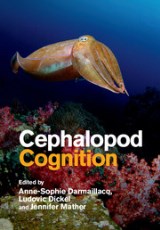Cephalopod Cognition
 Anne-Sophie Darmaillacq, Ludovic Dickel and Jennifer Mather (Eds)
Anne-Sophie Darmaillacq, Ludovic Dickel and Jennifer Mather (Eds)
Cambridge University Press, £58.50
The coleoid cephalopods include cuttlefish, octopus and squid. The difference between these and the nautilids arose from competition with bony fishes during the Cretaceous period, driving the two lineages into different niches. The coleoids represented "live fast die young" while the nautilids "live slow die old".
The coleoid cephalopods are characterised by their use of visual cues in learning, especially their complex eye structure for hunting, communication and defence. The nautiloids, by comparison, have only simple eyes, which probably cannot form distinct images, and a smaller optic lobe than their relatives.
Cephalopods are organisms on the make, always looking to exploit their environment by the application of their sophisticated biology. An aspect that intrigued me was how individuals mimic the colour and texture of their immediate surroundings, resulting in perfect camouflage, but without the loss of foraging ability (see Chapter 8, page 180), referred to as dynamic camouflaging as opposed to static, where change is impossible.
Furthermore, the most studied coleoid cephalopods are colour blind. Their eyes possess only a single mid-wavelength visual pigment, whereas the specialist chromatophore, leucophore and iridophore cells in their skin (controlled by a complex nervous system) can reflect the chromatic characteristics of local fields, resulting in partial matching. When coupled with textual changes to the skin, this alters organisms' appearance to confuse predators.
There are nine other chapters about these enigmatic creatures worthy of your time. If I have whetted your appetite, then read the book – it's expensive, but well worth the cover price.


